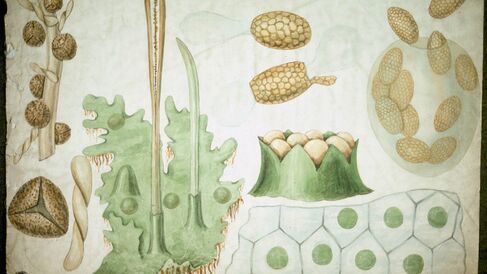The Henslows: two generations of Cambridge botanists

John Stevens Henslow and his son George were both botanists, and both studied at the University of Cambridge in the 19th century. The Whipple Museum has over 100 botanical teaching diagrams illustrated by the two men. In addition, the Museum has one microscope bought by John Stevens Henslow, and a microscope and micro-spectroscope given to the University by George Henslow.
Get ready for Halloween this half term with our ‘spooky’ bone activities at the Sedgwick Museum. We will be exploring old x-rays, studying the bones in your hand and coming face to face with Bony Tony.
Location: The Sedgwick Museum
All ages, drop in, free
Catch us at Anglia Ruskin University alongside other Cambridge University Museums, making planet and globe decorations.
Location: Anglia Ruskin University (walk through to Bradmore Street entrance from Petersfield).
Free, all ages, drop in
Henslow's Cambridge
When John Stevens Henslow (1796-1861) was appointed to the chair of Botany at Cambridge in 1825 he claimed to know "very little indeed about botany ... [probably] as much of the subject as any other resident in Cambridge". Despite this modest claim Henslow transformed the study of botany at the University. His lectures and informal meetings were popular, and the large and beautifully illustrated botanical diagrams that he used for teaching are currently held at the Whipple Museum. As well as rejuvenating the study of botany, Henslow laid the plans for the replacement of the old botanical garden with a new 40 acre garden, which was officially opened in 1846. In 1851 he purchased a large compound microscope from the London-based firm Smith & Beck, now in the collections of the Whipple Museum . Incidentally, Henslow's protégé, Charles Darwin, had bought a similar microscope from the same company in 1846.
Henslow's microscopes in the Whipple Museum
As well as John Stevens Henslow's large microscope the Whipple has a small dissecting microscope and a micro-spectroscope attachment for a large microscope, both of which carry the same handwritten label: 'from Prof. G. Henslow'. George Henslow (1835-1925) was John Stevens's son, and followed his father in becoming a lecturer in botany, even using his father's diagrams. The dissecting microscope was made around 1859, when George had just graduated from the University of Cambridge. It is likely that both father and son used the microscope for their botanical researches. The micro-spectroscope accessory was made in 1878, and was certainly the property of George Henslow (his father died seventeen years earlier). When these objects were first exhibited in Cambridge in 1936. the label read:
"Sorby's Microspectroscope for Ross Microscope. To facilitate spectroscopic examination of very small quantities of coloured substances, and to determine the position of their absorption bands relatively to the known ... [spectral] lines."
Spectral lines
Spectral lines are dark lines that appear in a spectrum of light when looking through a spectroscope. The lines are caused by electrons in chemical elements absorbing the energy present in light. Spectral lines can be analysed to find out the identity of an unknown substance. Each element absorbs light in a different part of the spectrum, giving a unique pattern of lines, like a fingerprint, for a particular substance. So, you can identify the make-up of a substance by comparing its unique spectral fingerprint with lines that are already known.
Boris Jardine
Boris Jardine, 'The Henslows: two generations of Cambridge botanists', Explore Whipple Collections, Whipple Museum of the History of Science, University of Cambridge, 2007.
